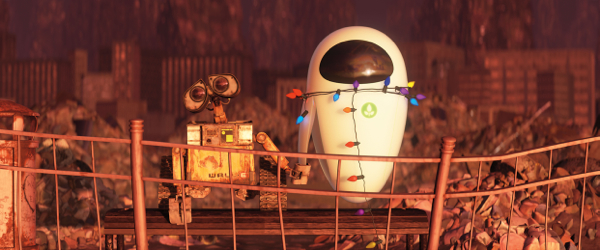Movie review by Greg Carlson
During the sensational opening section of Pixar’s “WALL-E,” the last functioning Waste Allocation Load Lifter Earth-Class robot dutifully fulfills a daily routine of mashing piles of garbage into small cubes and stacking them until they reach monumental heights. Against the backdrop of a dusty, desolate landscape that recalls Tom Petty’s “You Got Lucky” video (among several other post-apocalyptic visions), the soulful WALL-E either doesn’t know or doesn’t care that no human beings are around to appreciate his efforts. WALL-E’s only companion is a scuttling cockroach who tags along while the indefatigable bucket of bolts engages in his Sisyphean task. Wordless and haunting, the purely visual exposition emulates the poetic narratives of Buster Keaton and Charlie Chaplin, whose work director Andrew Stanton has claimed the moviemaking team studied intensely.
Blending a classic love story with a less effective environmental message, “WALL-E” is at its best when expressing the title character’s ardent desire to hold hands with another robot willing to reciprocate his unlikely emotion. Stanton’s clever use of a couple of songs from “Hello, Dolly!” gives the tired musical a brand new life, and it is rather easy to speculate that the next generation of moviegoers will not be able to hear “Put On Your Sunday Clothes” and “It Only Takes a Moment” without filtering them through WALL-E’s consciousness.
Resembling Number 5 from “Short Circuit,” WALL-E is a marvel of character animation. With “vocalizations” provided by legendary sound designer Ben Burtt, who brought the voices of R2-D2, Chewbacca, and many other creatures to life in “Star Wars,” WALL-E finds himself in good cinematic company. As one has come to expect from Pixar, the movie teems with visual quotations, in this case touching on many Hall of Fame science fiction films, from “Metropolis” to “Blade Runner.” Pixar fans will also find multiple references to previous movies from the studio’s formidable oeuvre.
“WALL-E” is composed of three sections, and the first two are vastly superior to the third, which loosens its grip on the robot protagonists long enough to let a mothership of obese interstellar travelers drive home a nearly tedious gag about fat Americans. Jeff Garlin voices the captain of the floating city Axiom, a gorgeously designed spacecraft that looks like something out of John Berkey’s beloved fantasy painting. Garlin is surely a talented performer, but the movie is infinitely more engaging without the unnecessary chatter of explanatory dialogue. This is a minor complaint, however, as “WALL-E” pretty consistently delivers the goods.
The middle section of the movie is the likeliest to appeal to the youngest members of the viewing audience, and some might quibble that a sequence involving a collection of malfunctioning, “rogue” robots panders to kids whose attention spans might be tested by the rest of the film. Fortunately, WALL-E’s relationship to his soul-bot EVE is wonderful enough to silence all but the crustiest of critics (despite the considerable number of times EVE pleadingly pronounces the hero’s name). In one glorious scene, WALL-E and EVE share a zero gravity dance together that echoes the breathtaking outer space ballets choreographed by Kubrick in his masterpiece “2001: A Space Odyssey.” For this, and many of its other stunning compositions, “WALL-E” is one of the few must-see titles of the summer movie season.
